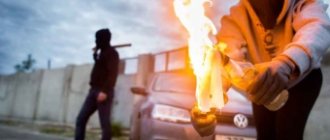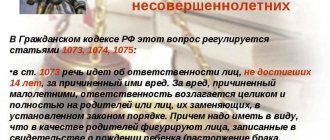Liability for arson of a car is provided for in Art. 167 of the Criminal Code of the Russian Federation. More precisely, it may occur under this article, since this norm covers any intentional destruction or damage to someone else’s property that caused significant damage.
Since we are considering the arson of a car, such an action is qualified under Part 2 of Art. 167 of the Criminal Code of the Russian Federation. Similar liability will apply if the crime is committed out of hooligan motives or results in the death of a person through negligence, as well as other grave consequences.
Which article does it belong to?
Deliberate arson is considered in Article 167 of the Criminal Code of the Russian Federation. It is also an article for arson of a car, since this act involves causing significant damage as a result of a fire.
Arson also appears as a consequence of such an offense as violation of fire safety rules , therefore it is also interpreted by Art. 219 of the Criminal Code of the Russian Federation.
Attention! If a person died as a result of the incident, then the actions of the perpetrator will be qualified under Art. 109 of the Criminal Code of the Russian Federation, which determines preventive measures for killing a person through negligence. The crime in this case will be considered in conjunction with Art. 167 of the Criminal Code of the Russian Federation.
Let's say that as a result of the incident some property of a citizen , then Art.
167 will be used in conjunction with Art. 168 of the Criminal Code of the Russian Federation, which qualifies damage to property. The Code of Administrative Offenses of the Russian Federation has Art. 20.4, which provides for a fine in case of grass burning (from the point of view of the legislation of the Russian Federation, this is not such a serious crime).
There is a separate article for arson of a forest - Art. 261 of the Criminal Code of the Russian Federation. It consists of two parts that determine the punishment for intentional and unintentional arson.
Depending on the circumstances of the incident, this act may also be qualified under these articles of the Criminal Code of the Russian Federation:
- Part 1 Art. 205, if the arson took place during a terrorist act;
- Part 1 Art. 212 - if committed during mass riots;
- when causing serious harm to health - Art. 112 or lung - Art. 115.
Judicial practice: sentences and punishment under Art. 168 of the Criminal Code of the Russian Federation
- Resolution of the Plenum of the Supreme Court of the Russian Federation dated... PLENARY OF THE SUPREME COURT OF THE RUSSIAN FEDERATION DECISION dated December 27, 2002 N 29 ON JUDICIAL PRACTICE IN CASES OF THEFT,...
- Decision of the Supreme Court: Resolution No. 310P13 dated... DECISION OF THE PRESIDIUM OF THE SUPREME COURT OF THE RUSSIAN FEDERATION Case No. 310-P13 Moscow January 23, 2014 Presidium of the Supreme Court of the Russian Federation...
- Decision of the Supreme Court: Determination N 203-APU17-21... THE SUPREME COURT OF THE RUSSIAN FEDERATION Case No. 203-APU17-21 APPEAL DECISION Moscow August 31, 2021 Judicial Collegium for Military Personnel of the Supreme...
- Resolution of the Presidium of the Supreme Court of the Russian Federation dated... PRESIDIUM OF THE SUPREME COURT OF THE RUSSIAN FEDERATION DECISION dated December 5, 2018 N 126-P18 ON RESUMING PROCEEDINGS IN THE CASE DUE TO NEW...
- Judicial Collegium for Criminal Cases, appeal:... THE SUPREME COURT OF THE RUSSIAN FEDERATION Case No. 72-APU 17-21 APPEAL DECISION Moscow October 04, 2021 Judicial Collegium for Criminal Cases...
- Resolution of the Plenum of the Supreme Court of the Russian Federation dated... PLENARY OF THE SUPREME COURT OF THE RUSSIAN FEDERATION DECISION of November 15, 2021 N 48 ON THE PRACTICE OF APPLICATION BY COURTS OF LEGISLATION GOVERNING FEATURES...
- Resolution of the Plenum of the Supreme Court of the Russian Federation dated... PLENAUM OF THE SUPREME COURT OF THE RUSSIAN FEDERATION DECISION dated June 25, 2021 N 18 ON JUDICIAL PRACTICE IN CASES OF CRIMES,...
- Ruling of the ECtHR dated 02/14/2017 EUROPEAN COURT OF HUMAN RIGHTS THIRD SECTION CASE “MASLOVA VS. RUSSIAN FEDERATION” (Complaint No. 15980/12) JUDGMENT…
- Decision of the Supreme Court: Resolution No. 156P17 dated... DECISION OF THE PRESIDIUM OF THE SUPREME COURT OF THE RUSSIAN FEDERATION on the resumption of proceedings in the case due to new circumstances Case No. 156-Ш7 Moscow 27...
- Resolution of the Plenum of the Supreme Court of the Russian Federation dated... PLENAUM OF THE SUPREME COURT OF THE RUSSIAN FEDERATION DECISION dated December 17, 2021 N 43 ON SOME ISSUES OF JUDICIAL PRACTICE IN CASES...
How is the crime determined: reasons for arson
If a citizen has committed arson , then to qualify this crime, its elements are considered. Its important component is the subjective side of the act, since it could be committed with or without intent.
What does this mean:
- arson is considered committed with intent if a citizen set fire to someone else’s property and at the same time was fully aware of the negativity of his act, and also wanted serious consequences to occur;
- unintentional in cases where a person knew what the fire would lead to, but did not want its negative result.
The object of the offense is the objects of someone else's property: a vehicle, real estate, as well as the safety, health and life of citizens.
The objective side of the act is causing varying degrees of harm to someone else’s property or another person.
The subject of the crime is a legally competent citizen who has reached the required age by law.
The subject of arson is usually other people's property.
Evidence
To prove that the destruction of someone else's property as a result of arson actually took place, an investigation is conducted.
During it, evidence is collected that would help establish the reasons for the arson and how it was committed. This could be any explosive or chemical substances, abandoned matches, or lighters.
A survey is also conducted of those persons who were at the scene of the incident or nearby during the fire , CCTV camera records are reviewed, if any, and other citizens who could have filmed the incident on a photo or video camera are also involved.
When does administrative responsibility arise?
The norms of Article 7.17 of the Code of Administrative Offenses of the Russian Federation include intentional damage to someone else's property in the amount of up to 5 thousand rubles. The sanction of the article involves the collection of a fine from the violator in the amount of 300-500 rubles.
Note!
You can be held liable both for the destruction of a relatively inexpensive item - an item of clothing, an accessory, a gadget, or equipment of a catering establishment, as well as for minor damage to an expensive item, the repair of which would fall within this amount.
Qualification of crimes
When qualifying arson, the subjective side of the offense plays a huge role, namely whether it was committed with or without intent. Let's consider both options in more detail.
Deliberate arson
Reference. Let us recall once again the meaning of the concept of “direct intent”. This is a form of guilt that has two important components: the citizen was both aware of the illegality of his act and wanted its negative consequences to occur.
Arson is considered intentional in the following cases:
- it took place using special flammable or explosive substances. All of them were brought to the scene of the incident in advance;
- improvised means (paper, gasoline) were used for the purpose of ignition;
- the offender imitated an offense using various objects (damage to wiring, electrical appliances, etc.);
- creating other conditions necessary for a fire to occur.
Unintentional arson
This includes those types of fires that occur as a result of careless handling of fire, negligence or ordinary inattention of citizens. The criminal might have known about the fire, but did not want it to happen.
Arson is considered unintentional if:
- it was caused by cigarette butts or matches left unextinguished;
- candles, torches, lanterns or other objects that use open fire were left upside down;
- the cause of the arson was a lighted fire without observing basic safety rules;
- The cause of the arson was careless handling of pyrotechnics, etc.
How to draw up a property damage report
Often, legal entities, private and public enterprises, departments and institutions are faced with the registration of damage caused to property. For them, drawing up an act is mandatory not only to bring criminals to justice, but also to write off damaged property from the balance sheet, allocate funds for unplanned repairs and other financial reporting procedures. In addition, if damage was caused by the actions of an employee, he may be subject to disciplinary action based on the act.
The document is drawn up by an authorized official - the head of the department that services the damaged facility, an employee responsible for material assets, a secretary or an accountant. Several employees must be involved in the inspection and recording of damage, who act as witnesses and sign the report together with the compiler. The document itself must have the following parts:
- name of the company, date and place of compilation;
- title and number of the document;
- data of the compiler and the workers present;
- name of the damaged property, degree of damage, preliminary assessment of damage;
- circumstances of damage and information about the culprit (if known).
Private individuals are most often faced with the need to draw up a report on damage in the housing and communal services sector - in case of flooding of an apartment by neighbors, a fire in a nearby apartment and other domestic force majeure. In this case, a commission from the management company servicing the house should be invited to draw up the act. If the culprit is known, he can participate in drawing up an inventory of the damage. The act specifies:
- address of the affected premises and owner details;
- the time and circumstances of the incident;
- location of the emergency in the apartment - a corner of the bedroom, a leak in the center of the living room, etc.;
- damaged surfaces indicating finishing materials, and other damaged property - equipment, books, documents;
- amount of damage;
- information about the cause of the incident and the culprit, if established;
- data of the drafters of the act.
How is the punishment for arson determined?
When determining punishment for arson, a whole range of factors that took place during the incident are considered.
In doing so, the court takes into account both aggravating and mitigating circumstances. If we talk about liability for arson of a car or other property, then, most likely, Part 2 of Art. 167 of the Criminal Code of the Russian Federation. It provides for the following preventive measures:
- forced labor for 5 years;
- imprisonment for the same period.
How can you prove lack of intent?
To do this, law enforcement agencies resort to a comprehensive analysis of the items found at the scene, as well as photographs and videos that were taken there.
For proof, they also invite specialists who are able to draw conclusions about the condition of wiring or electrical appliances, if any were present at the fire site. After all, its cause could be an ordinary short circuit.
Actions of the victim
The first thing to do if you find yourself in such a situation is to try to objectively assess the harm caused to you. At the same time, it must be documented and expressed in specific numbers. Even in the event of damage to property due to negligence and by a person you know, it is better to resort to this method.
If there is such a possibility, then it is better to conduct an independent examination so that the expert can compare the market value of the object at the time when it was damaged or destroyed, taking into account the amount of money required to restore it.
Is it possible to withdraw a statement from the police? You can read about this in this article.
What does an expert usually consider and what difficulties does he encounter? When assessing damage to, for example, a vehicle, it is always difficult to assess it if it has been burned. Usually a specialist finds out its real price on the market, as well as any breakdowns that occurred before, accidents, etc.
Try to first conduct an independent examination of the damaged property.
If we are talking about very expensive equipment, then they consider the brand, technical characteristics, etc.
Let's say damage or destruction was caused to a house or apartment. Then their value is taken from the cadastral register and the price of repair work.
In the case of damage to luxury items, a receipt is almost always required to determine its actual value, since it is usually kept when purchasing such items.
If the case is under the article for damage to state property, then the examination is carried out by the authorities responsible for this.
After you have achieved an adequate examination, you need to contact the police department to conduct an investigation.










